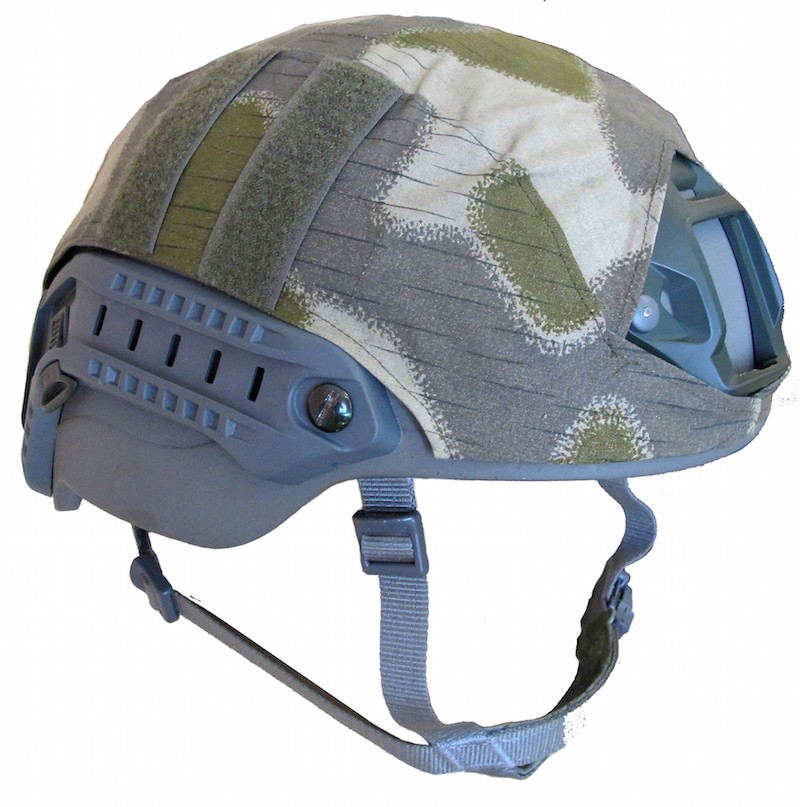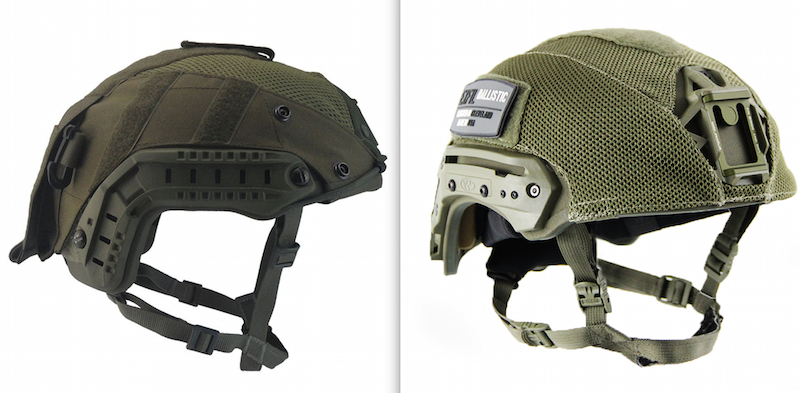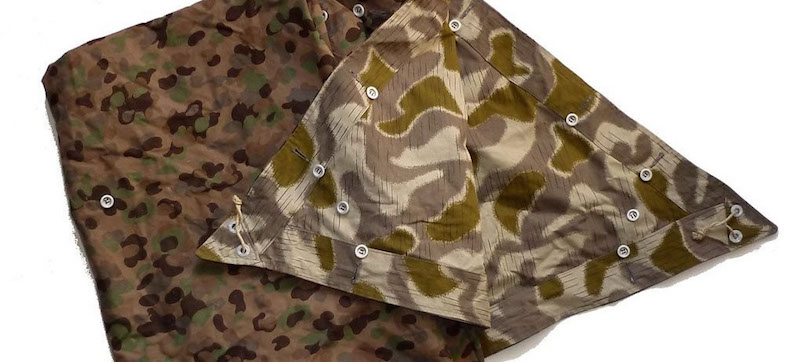Get the weekly SPARTANAT newsletter.
Your bonus: the free E-Book from SPARTANAT.

Helm: Austrian stone camouflage for the new Ops-Core
This text discusses the importance of protecting expensive helmets like the Ops-Core SEntry XP Mid Cut used by the Austrian Armed Forces. It introduces the ATSSC-AU helmet cover developed to protect the helmet from splinters and bullets. The cover is made from retired ÖBH shelter sheets and features a camouflage pattern similar to the Austrian tactical splinter shape concealment. The text also provides a historical background on helmet covers and their significance in military operations.
Current state of situational elasticity: Put on the helmet! Every expensive mobile phone gets a fancy, practical, fashionable, sensible (or not) protective case - WHY not the most expensive helmet ever owned by the Austrian Armed Forces (ÖBH), the beloved Ops-Core SEntry XP Mid Cut? HERE on SPARTANAT we have already presented you with this great piece. Now we go one step further.
A ballistic cover around the head is intended to reduce the impact of splinters and bullets - in order for it to do so, it must be protected, since the combat helmet of the Austrian soldiers is used as a "universal protection helmet". The armored grenadiers contact the corners and advances on their tank just as often as mountain troops encounter rocky outcrops or falling stones, ... until ballistic action is taken, the helmet shell should be protected as much as possible from such influences and constant UV radiation. The user manual already specifies this on page ten.

Professional helmet covers: Raptor by Agilite from Israel for the OpsCore Ballistic FAST Helmet (left), Team Wendy Ballistic with cover from the US manufacturer itself (right).
Clever "Geardos" have already stocked up. The offer is HUGE at first glance. From the five Euro piece from China to the high-end Corduramesh from Israel by Agilite for a mere hundred. But! Our Sentry has a completely different geometry than the common Ballistic or Polymer Ops Core FAST BUMP helmets or helmets from other manufacturers, such as Wendy System, ...
So, get your sewing machine out, suitable fabrics, Velcro patches, etc. can be found in every barracks or cost a fraction of what you are currently spending in the market for suitable covers. Velcro patches, straps, buttons, compensating pockets, mesh inserts - standard? No. As a basic model, protecting the surface may be enough, the number, size, shape, color, and attachment of additions must be based on the need (DON DOFF).
Here comes ATSSC-AU! Or simply "Austrian tactical splinter shape concealment - AU (arid, urban)"
For example: Our ATSSC-AU. The occasion: The tri-national military exercise Common Schallenge 2017 in Montenegro (Photo story coming soon here on SPARTANAT). The reconnaissance of the exercise area in the foothills of the Dinaric Mountains revealed, among other things, that in the attack routes over predominantly steep climbing terrain, not only poisonous vipers pose a real threat, but also falling rocks would endanger the practicing soldiers.
One accompanying measure from the assessment of the environmental conditions was also the protection of the equipment. The Mountain Troops editorial staff has had a pattern for the Sentry for half a year, custom-made from a retired ÖBH shelter sheet. The birth of the ATSSC-AU helmet cover! Making a virtue out of necessity is a kind of creed of Austrian soldiers. A considerable number of old shelter sheets could be obtained (!) from the various magazines of the training units, as these indestructible treasures still serve as coverings and ground sheets. With the support of the (thankfully still existing) saddlery of the operational squadron and available material, the contingent could be equipped with helmet covers. Background Steintarn: The shelter sheet (officially shelter sheet) of the ÖBH was produced from 1957 until about 1980. One side printed with the camouflage pattern introduced in 1957 for the combat suit 1957/59, the other side with the so-called "Steintarn" (stone camouflage). Both camouflage patterns are considered independent developments, but are unmistakably influenced by earlier German developments.
The Steintarn pattern, with its overlapping geometric shapes and overprinted "rain streaks," is classified as a splinter camouflage pattern due to its color and shape distribution. Splinter camouflage patterns are currently worn by, for example, the Swedish Army, and their excellent properties for "contour resolution" are undisputed even in the age of pixelation, the elaborate adaptation to changing environmental conditions (cf. Digi-/Pixel camouflage) has so far prevented broader introduction.

Comparison: Camouflage patterns ATACS-AU (left) and Steintarn pattern. Squint, increase viewing distance - the distribution of the areas appears similar.
Modern terminology would refer to the proven camouflage pattern, for example, as "Austrian tactical splinter shape concealment - AU (arid, urban)". So: Austrian tactical splinter shape concealment for arid areas and urban environment. The color and distribution of one of the most modern camouflage patterns, developed by the US company Digital Concealment Systems (DCS), strongly resembles our Steintarn from the seventies of the last century, even though in this case a completely different system is used. ATACS-AU replaces the traditional pixel camouflage pattern (square pixels) with so-called organically looking pixel clouds. Developed for a wide range of possible deployment areas, these "clouds" can be varied in shape and color. (Variants = box). ATACS variants are worn by various Special Operations Forces, as well as the Armed Forces of Peru and units of the Chinese People's Liberation Army. The most well-known users of ATACS are the Russian Spetsnaz.
Mountain Troops Editorial Staff
Kurnik, Lt.
The history of helmet covers in the English version of WikiPedia:
The helmet cover was first used by French soldiers during World War I.
... Helmet covers are used by most armies and are in the camouflage pattern of the country/military's camouflage pattern, but some armies do have different covers to the uniform, for example Austrian Bundesheer wear several different helmet covers and have not got one standardized cover for every soldier. The Israeli Defense Forces use a large, floppy helmet cover to break up the outline of the soldier. The US Army from the late 1950s to the mid-late 1980s used a dual-sided camouflage cover (one side a leafy green, the other a blobby orange) with its steel helmets while the rest of the uniform was green. ...
The OPS-CORE Sentry XP on SPARTANAT:

Stretcher party, combat medics with Universal Carrier 2000 unicycle during the maneuver in Montenegro. Steintarn looks particularly magnificent in rocky surroundings.
SPARTANAT is the online magazine for Military News, Tactical Life, Gear & Reviews.
Send us your news: [email protected]
Ad
similar
Get the weekly SPARTANAT newsletter.
Your bonus: the free E-Book from SPARTANAT.




